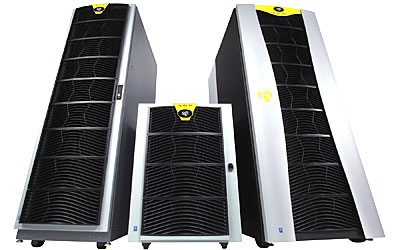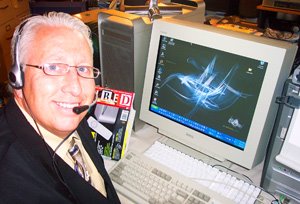Project Ultraviolet!
Thanks to advances in the speed of supercomputer simulations, complex phenomena such as weather systems, protein folding, and nuclear explosions are becoming easier to model and understand. But only a small part of this speedup is due to faster processors. Instead, the most common way to reach supercomputing capacities is to assemble hundreds or thousands of separate machines in clusters. When yoked together, such a cluster will shares a single memory and can perform massive simulations in parallel by breaking up the work into many small parts.

Mountain View, CA-based Silicon Graphics, also known as SGI, builds some of the world's largest supercomputing clusters. The fourth-fastest one in the world, for instance, is Columbia, a system that SGI built for NASA Ames Research Center in 2004. Columbia includes 20 SGI Altix "superclusters," each with 512 processors, for a total of 10,240 processors that share a 20-terabyte memory.Cooling this behemoth (which NASA uses to model problems involving large amounts of data, such as climate change, magnetic storms, and designs for hypersonic aircraft) is currently a very low-tech affair: it's accomplished mainly by blowing air past the processors at high speed.
Eng Lim Goh, a computer scientist and chief technical officer at SGI, says one NASA administrator told him, "'I spent millions of dollars on your supercomputer just so we could run simulations that replace our wind tunnel -- and you gave us a new wind tunnel.'"
Goh is now the leader of Project Ultraviolet, SGI's effort to develop its next generation of superclusters. The chips that SGI is designing for Ultraviolet will run applications faster - yet use less electricity and produce less heat.
Note from Technophile: So how did SGI make applications run cooler? They broke problems down into pieces and the way they allocate those to the processors. They did an analysis of about 50 customer applications to see what was going wrong with these applications when they were running in parallel. They were able to identify five major problem areas. This allowed them to develop the Ultraviolet design which incorporates the following improvements: 1) More reliable memory, 2) less communications latency, 3) more communications bandwidth, 4) better load balancing, and 5) less memory latency.:: Source: [Technology Review].
:: Image credit: Silicon Graphics.
:: Keywords: [next generation hec architecture], [multi-paradigm computing], [petaflops], [high-end computing], [supercomputer], [petabytes], [climate modeling], [weather systems], [cluster], [supercluster], [supercomputer simulations], [project ultraviolet], [sgi], and [silicon grahics].




















0 Comments:
Post a Comment
<< Home